SLLS753E February 2007 – September 2016 SN65HVD1040-Q1
PRODUCTION DATA.
- 1 Features
- 2 Applications
- 3 Description
- 4 Revision History
- 5 Description (continued)
- 6 Pin Configuration and Functions
-
7 Specifications
- 7.1 Absolute Maximum Ratings
- 7.2 ESD Ratings
- 7.3 Recommended Operating Conditions
- 7.4 Thermal Information
- 7.5 Electrical Characteristics: Supply Current
- 7.6 Electrical Characteristics: Driver
- 7.7 Electrical Characteristics: Receiver
- 7.8 Switching Characteristics: Device
- 7.9 Switching Characteristics: Driver
- 7.10 Switching Characteristics: Receiver
- 7.11 STB Pin Characteristics
- 7.12 SPLIT Pin Characteristics
- 7.13 Typical Characteristics
- 8 Parameter Measurement Information
- 9 Detailed Description
- 10Application and Implementation
- 11Power Supply Recommendations
- 12Layout
- 13Device and Documentation Support
- 14Mechanical, Packaging, and Orderable Information
8 Parameter Measurement Information
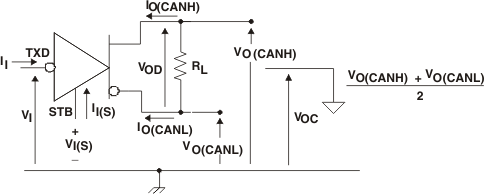 Figure 11. Driver Voltage, Current, and Test Definition
Figure 11. Driver Voltage, Current, and Test Definition
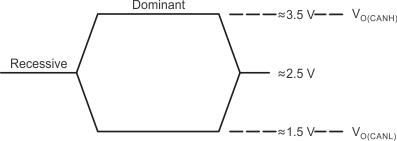 Figure 12. Bus Logic-State Voltage Definitions
Figure 12. Bus Logic-State Voltage Definitions
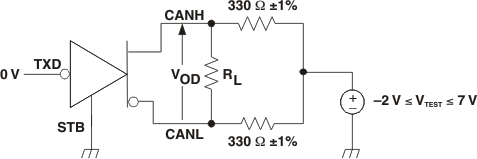 Figure 13. Driver VOD Test Circuit
Figure 13. Driver VOD Test Circuit
 Figure 14. Driver Test Circuit and Voltage Waveforms
Figure 14. Driver Test Circuit and Voltage Waveforms
 Figure 15. Receiver Voltage and Current Definitions
Figure 15. Receiver Voltage and Current Definitions

A. The input pulse is supplied by a generator having the following characteristics: PRR ≤ 125 kHz, 50% duty cycle, tr ≤ 6 ns, tf ≤ 6 ns, ZO = 50 Ω.
B. CL includes instrumentation and fixture capacitance within ±20%.
Figure 16. Receiver Test Circuit and Voltage Waveforms
Table 1. Differential Input Voltage Threshold Test
| INPUT | OUTPUT | |||
|---|---|---|---|---|
| VCANH | VCANL | |VID| | R | |
| –11.1 V | –12 V | 900 mV | L | VOL |
| 12 V | 11.1 V | 900 mV | L | |
| –6 V | –12 V | 6 V | L | |
| 12 V | 6 V | 6 V | L | |
| –11.5 V | –12 V | 500 mV | H | VOH |
| 12 V | 11.5 V | 500 mV | H | |
| –12 V | –6 V | 6 V | H | |
| 6 V | 12 V | 6 V | H | |
| Open | Open | X | H | |

A. CL = 100 pF and includes instrumentation and fixture capacitance within ±20%.
B. All VI input pulses are supplied by a generator having the following characteristics: tr or tf ≤ 6 ns, pulse repetition rate (PRR) = 125 kHz, 50% duty cycle.
Figure 17. ten Test Circuit and Waveforms

A. All VI input pulses are from 0 V to VCC and supplied by a generator having the following characteristics: tr or tf ≤ 6 ns, pulse repetition rate (PRR) = 125 kHz, 50% duty cycle.
Figure 18. Common-Mode Output Voltage Test and Waveforms

A. CL = 100 pF and includes instrumentation and fixture capacitance within ±20%.
B. All VI input pulses are from 0 V to VCC and supplied by a generator having the following characteristics: tr or tf ≤ 6 ns, pulse repetition rate (PRR) = 125 kHz, 50% duty cycle.
Figure 19. t(LOOP) Test Circuit and Waveforms

A. All VI input pulses are from 0 V to VCC and supplied by a generator having the following characteristics: tr or tf ≤ 6 ns, pulse repetition rate (PRR) = 500 Hz, 50% duty cycle.
B. CL = 100 pF includes instrumentation and fixture capacitance within ±20%.
Figure 20. Dominant Time-Out Test Circuit and Waveforms
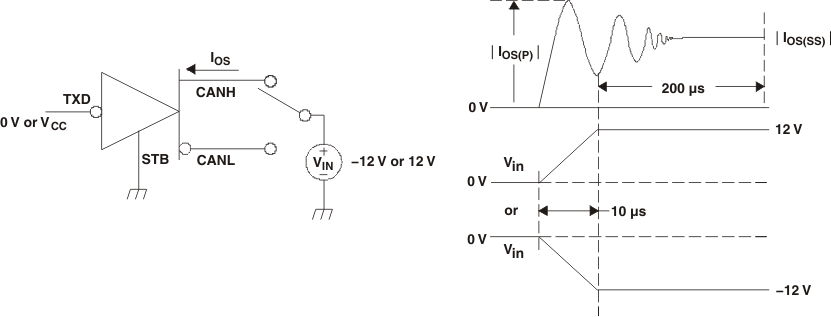 Figure 21. Driver Short-Circuit Current Test and Waveforms
Figure 21. Driver Short-Circuit Current Test and Waveforms

A. For VI bit width ≤ 0.7 µs, VO = VOH. For VI bit width ≥ 5 µs, VO = VOL. VI input pulses are supplied from a generator with the following characteristics: tr/tf < 6 ns.
B. CL = 15 pF and includes instrumentation and fixture capacitance within ±20%.
Figure 22. tBUS Test Circuit and Waveforms
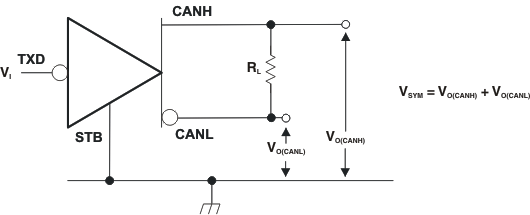
A. All VI input pulses are from 0 V to VCC and supplied by a generator having the following characteristics: tr/tf ≤ 6 ns, pulse repetition rate (PRR) = 250 kHz, 50% duty cycle.
Figure 23. Driver Output Symmetry Test Circuit